Remember “Spring Spheres?” Somewhere in Seattle a school supposedly banned the term “Easter eggs” because it was felt to be “non-inclusive.” The usual suspects were enraged. Those of us on the side of a somewhat more robust form of “inclusiveness” cringed and looked away.
It was most likely a hoax. But the point is, it might not have been. Add one more site of struggle for the so-called culture wars, the “War on Christmas Now Easter Is Nothing Sacred” traditionalists versus the “Kumbaya We Are The World” includists and watch how life has imitated art.
Halloween is out. “Black and Orange Day” is in. In fact, this has been going on for quite a while. The exact-same justification for the “Spring Spheres” is offered, but without the trace of a knowing smile. Here it is, from the Toronto District School Board.
Halloween is a religious day of significance for Wiccans and therefore should be treated respectfully.
Peer and social/media consumer pressures target all children and their families as consumers of costumes, makeup, food products, etc. Many students and their families can feel this socio-economic marginalization keenly.
The images and icons associated with consumer-oriented Halloween can come into conflict with some students’ and their families’ religious beliefs.
The food products that are marketed heavily during the Halloween period can come into conflict with students’ and their families’ dietary habits.
Some students have had first-hand traumatic experiences of violence that make talking about death, ghosts, etc., extremely alienating.
Many recently arrived students in our schools share no background cultural knowledge of trick-or-treating or the commercialization of death as “fun.”
If it were’t so all-fired non-inclusive, I’d be tempted to yell, “Jesus Christ!”
It is precisely this sort of earnestness that certain folks, imagining that they’re being progressive, wear like self-applied, entirely consensual shackles. It has nothing to do with inclusiveness, of course, except of the most shallow sort. It’s no more than moral self-pleasuring. They offer up an embarrassing caricature, one that falls like manna into right-wingers’ laps, feeding their delusions and justifying their ever-present paranoia.
So, for the anthropological illiterates, a few quick points.
First, culture is contestation — people continually interpret and reinterpret the symbols that define their society. It is not a thing, but a signifier that refers to a process. Consider some well-known cultural markers in the Inuit community. Square dancing (from visiting whalers). Syllabics (developed by a white missionary, used by Inuit other than Inuinnaqtun speakers who use Roman orthography). Soapstone carving (almost unknown until the late 1940s, when a white man, James A. Houston, encouraged Inuit to engage in it). Inuit, with full agency, made these aspects of their cultural life their own.
Blues and jazz, both originating from Black slaves, were adopted by whites. The Japanese “adopt, adapt, adept” is almost a cliche. New ideas, artifacts, images and forms of expression sometimes originate from a member of a group and sometimes arrive as “imports” that are then vernacularized and re-purposed. Either way, they can be appropriated by the group as a whole, and become part of its “culture.” All culture is appropriation. No “culture” resembles what it was a century ago, or even fifty years ago. Think of the historical blink-of-an-eye acceptance of homosexuality, or choice on abortion.
There is, then, no essence of “culture” to be protected — either “Canadian culture” or what immigrants bring with them. There is only the ceaseless interpersonal dynamics of a society. Authorities who try to interfere in that process, no matter how well-meaning, do not have a glowing record of success. “Cultures” are complex. If we can learn from history, they should neither be imposed nor protected from on high. Nor can they be. The people will decide.
The second point is that “inclusiveness” can mean many things, like the word “solidarity.” As an old union hand, I always rejected the notion of a “solidarity” based upon papering over differences among the membership. That kind of “solidarity,” ignoring as it did the specific concerns of women, people of colour, the LGBTQ complex and so on, was only powerful on paper. A more lasting, deeper solidarity is built upon the active recognition of those differences of perspective and life-history, and the sharing of common goals predicated upon them.
“Inclusiveness” doesn’t mean avoiding differences while pretending to acknowledge them. It means the full participation of everyone in social and cultural life, not a weak liberal universalism that submerges all differences in a formless grey sea of non-contestation. If inclusiveness can only be achieved by excluding and marginalizing everyone—banning Hallowe’en, for example—then I want no part of it. It’s just the wrong way to go.
You can’t force a narrow, bureaucratic definition of culture upon people with any success (Pauline Marois had a go at it, but it didn’t get very far, and wouldn’t have worked even if she’d won the election), but you can’t get away with the opposite, either. Imposing differences from above, which is what official “multiculturalism” tends to do, is equally misplaced. These differences are just as fluid, just as contingent, as the “culture” of the majority. Reifying and fetishizing them is no more conducive to healthy social dynamics than attempted assimilation.
We can all agree that there must be protections in place against discrimination — full civic participation requires them. We can’t ignore the power dynamics at play in our society, and even identity politics may perhaps have its strategic uses, although I remain sceptical. But in the instant case — come on. It is condescending and patronizing to “protect” kids from different backgrounds from the imagined cultural oppression of Halloween.
Let them be.
And so this October 31, as in every other year, I greeted children of every imaginable creed and colour at my front door, and oppressed them with sugar.



